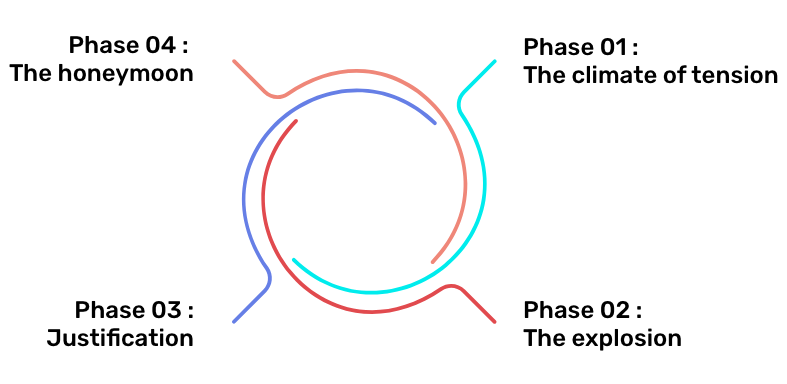
What is Olista?
Olista is the domestic violence centre supported by the Brussels region. Ultimately, the centre aims to be the reference point for:
• victim support;
• information and advice for professionals.
The victim support will be holistic and designed to meet all the needs that a victim of domestic violence may encounter on the road to recovery. Through its many partners, the centre will be able to provide the required support in the following areas: legal, psycho-social, administrative and medical.
Together, the partners will look for the best ways to act in order to help victims, work together and, through the creation of a joint action plan, consolidate their efforts to be more effective and efficient.
In May 2018, at the initiative of the Brussels-Capital-Ixelles Police district, the Dutch-speaking Brussels Public Prosecutor's Office and equal.brussels' Regional Domestic Violence Coordinator, a working group was set up to explore opportunities for improving the working relationship and information sharing between the different sectors involved in handling complex domestic violence cases.
Since September 2021, with technical support from and in consultation with equal.brussels, safe.brussels has been coordinating the steering group of the pilot project for an intersectoral approach to domestic violence in the Brussels-Capital Region, hereinafter referred to as the domestic violence intersectoral platform.
This group brings together partners from different sectors: police, public prosecutors (French- and Dutch-speaking sections), the law courts (French- and Dutch-speaking), social services, specialised regional and community legal and health services (French- and Dutch-speaking) and associations specialising in supporting victims and perpetrators.
The intent is to create a physical space where domestic violence victims can find all the services and tools they need. Olista will incorporate the domestic violence intersectoral platform and expand the services offered to victims.
• January 2024: opening of the Domestic Violence Centre (pilot phase, only accessible via partners);
• January 2025: opening to the public.

Project objectives
This collaborative project is designed to establish a process and tools for the consultation.
In the long term, the project aims to prevent domestic violence and reduce its individual and societal impact through intensive intersectoral cooperation.
To achieve this, the project has two main objectives:
• to develop a structured, collaborative process for the intersectoral handling of domestic violence cases;
• to create a physical space that will be an inter- and multi-disciplinary reception centre for victims.
The approach and management of domestic violence situations will be based on the cycle of violence

The approach and management of domestic violence situations will be based on the cycle of violence
Read moreThe cycle of domestic violence attempts to identify the repetitive processes involved in violence between partners. This model goes some way to explaining how the victim is led to stay with/return to the perpetrator despite what they are experiencing in the relationship.
This cycle is made up of four distinct phases that follow one another, forming a repetitive loop the intensity of which increases over time, with ever greater violence and at an accelerating pace.
In the diagram (to come), you'll find the perspective of the victim and the perpetrator for each of the four phases of the cycle. The victim is represented by green, the perpetrator by red.
Phase 1: the climate of tension
The perpetrator: tensions initiated by the violent person through various signals (heavy silence, threatening gaze, irritation, increased conflict, growing impatience, emphasis on mistakes, etc.).
The victim: attempts to ease the tension and relieve the pressure. They doubt themselves and their abilities and fear upsetting their partner.
Phase 2: the explosion
The perpetrator: acting out using violent behaviour (verbal, physical, psychological, economic, sexual, etc.) with or without the aid of objects to release the tension they feel.
The victim: feelings of fear, shame, humiliation, injustice, sadness, despair... They are distraught.
Phase 3: justification
The perpetrator: discourse designed to make them feel less responsible for their actions. They justify themselves in various ways (minimisation, referral to the outside world - "You didn't have to...", "You pushed me over the edge", "I'm too sensitive"...).
The victim: they doubt their own perceptions and accept the perpetrator's justifications. They question themselves, feeling responsible for the violence they have suffered. They believe that if they change their behaviour, the violence will stop. They may also want to help the perpetrator to change.
Phase 4: the honeymoon
The perpetrator: they calm down and express their regret. They make promises and give gifts aimed at reconciling with the victim. Or the perpetrator tries to make the victim feel guilty by threatening to harm themselves ("I'm going to see a shrink", "This is the last time" "I'll kill myself if you leave"...). They'll often refer to the context in which the couple met to support the special bond existing between the two partners.
The victim: the new-found calm soothes them, they hope for a change or that things will go back to the way they were, so they give the partner another chance. The victim may also support the perpetrator, or change their own habits to meet the perpetrator's expectations.
Olista will offer three different approaches:
When a situation of domestic violence is referred to it, it will appoint a contact person. After a detailed analysis of the situation, with the help of the victim themselves, the partners involved and risk detection tools, the contact person will opt for one of the following approaches:

Reassignment
The case is not handled by the centre but is returned to the source with recommendations (actions to be taken, institutions to be contacted);
Psycho-medico-social and legal hub
The case is taken on by the centre and referred to this department, which brings together partners from the associative, medical, psycho-social and legal sectors;
Case consultation
The case is taken on by the centre and referred to this unit, which brings together the public prosecutor's office, the police, the law courts and other partners from youth and child welfare agencies and the voluntary sector.
In the last two options, professionals work together in a coordinated manner on a given situation. The contact person is the point of reference for both the victim and the partners involved in the support process. They are responsible for monitoring and coordinating the partners' actions with and for the victim. Their external position gives them an overview of the working relationships established, and where necessary, to intervene to ensure that support is and remains optimal.
"Violence is a means of securing power over others. It's a power struggle in which one is the subject and the other the object."
LEGAL TEXTS and strategic documents
Definitions of domestic and family violence:
The Public Prosecutors' circular COL 3/2006 defines domestic violence Read ›
The Public Prosecutors' Circular COL 4/2006 provides a more precise definition of partner or domestic violence Read ›
The Istanbul Convention, ratified by Belgium in 2016, provides a broader definition of violence against women, including domestic violence Read ›
Strategic documents referring to the importance of improved multidisciplinary collaboration:
The Council of Europe Convention on Preventing and Combating Violence Against Women and Domestic Violence, signed in Istanbul on 11 May 2011, ratified by Belgium on 14 March 2016 and approved by the Law of 1 March 2016 (the "Istanbul Convention") Read ›
The Comprehensive Security Framework Note 2022-2024 (the "CSFN") Read ›
The joint general policy declaration of the Government of the Brussels-Capital Region and the United College of the Common Community Commission, 2019-2024 legislature (the "DPR") Read ›
The Brussels Plan to Combat Violence Against Women 2020-2024 (Action 46) Read ›
The Global Security and Prevention Plan 2021-2024 (the "GSPP") (Theme 1, measure 1.4) Read ›
Overview of domestic violence in the Brussels Region during the Covid-19 pandemic. March-November 2020, Focus no. 2 of the Observatory, February 2021 Read ›
The National Action Plan to combat all forms of gender-based violence 2021-2025 (the "NAP") (Priority II) Read ›
Contact
E-mail : olista@safe.brussels
Téléphone : 0490/68.63.81





